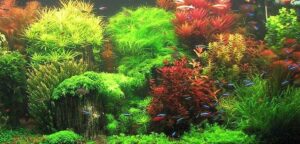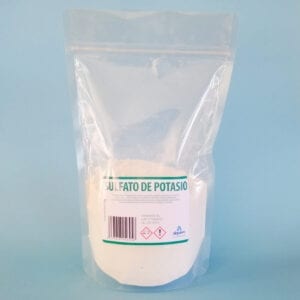If you are an aquarium specialist, or have been keeping your aquarium for a long time, you will already know that keeping plants green is an additional job to keeping fish. You will have noticed that it is easy for your plants to turn yellow or brown. If this happens, your plants are deficient in potassium. Of all the nutrients your aquarium plants need, potassium is the only one you can't get from your fish's own food. This lack of potassium can be solved by using the potassium sulphate. Let's take a look at the components that aquarium plants need:
Plants need macro- and micronutrients for their life cycle and aquarium plants are no exception.
Components required for aquarium plants

The macronutrientsThese are the nutrients that are needed in larger quantities. These components are: nitrogen (N), phosphorus (P), potassium (K), calcium (Ca), magnesium (Mg) and sulphur (S).
The micronutrients are the nutrients that plants need in smaller quantities, the so-called trace nutrients: iron (Fe), copper (Cu), zinc (Zn), manganese (Mn), boron (B) and molybdenum (Mb).
Important macronutrients such as nitrate and phosphate are provided to the plants through the feed and the organic waste generated by the fish, and the necessary micronutrients can be obtained by changing the tap water.
However, potassium is a macronutrient that is neither generated in aquariums nor can it be obtained in a significant way by changing the water; therefore, a potassium supply will be necessary for the maintenance of the plants in the aquarium. Potassium sulphate is the most commonly used compound to extract potassium.
Recommended dosage Potassium Sulphate Potassium Aquarium
When selecting the appropriate dosage of potassium sulphate for the aquarium it is necessary to take into account some factors such as the following:
- The size of the aquarium.
- The number of plants inside.
- The type of plant found in the aquarium.
- The lighting you have.
- Frequency of water change
A recommendation for a standard aquarium would be the following amounts:
50 grams of potassium sulphate mixed with 1L of water, stir well, and leave to stand for 24 hours. Then, for every 100L of aquarium water, add about 20ml of the solution. The frequency with which the 20ml of potassium sulphate per 100ml of water should be added is every 15 days, when changing the aquarium water.
In this video you can see an example of how to prepare potassium sulphate for aquariums:
How to notice potassium deficiency in an aquarium?
Potassium deficiency in aquarium plants can become evident when the leaves start to turn a little lighter, until white areas become transparent if left untreated. In the worst cases, holes will start to form in the leaves.
It is also advisable to fertilise if the plants are put in before the fish, as they will not have any nutrients.
Potassium sulphate is not only used for aquarium plants. It is also used for dry plant fertilisation, as potassium is one of the essential nutrients. Read more at this section.

¿ Sirve el fosfato diamonico y si es así, en que dosis? Gracias.